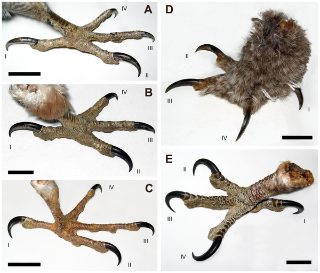Despite the ubiquity of raptors in terrestrial ecosystems, many aspects of their predatory behaviour remain poorly understood. Surprisingly little is known about the morphology of raptor talons and how they are employed during feeding behaviour. Talon size variation among digits can be used to distinguish families of raptors and is related to different techniques of prey restraint and immobilisation. The hypertrophied talons on digits (D) I and II in Accipitridae have evolved primarily to restrain large struggling prey while they are immobilised by dismemberment. Falconidae have only modest talons on each digit and only slightly enlarged D-I and II. For immobilisation, Falconini rely more strongly on strike impact and breaking the necks of their prey, having evolved a ‘tooth’ on the beak to aid in doing so. Pandionidae have enlarged, highly recurved talons on each digit, an adaptation for piscivory, convergently seen to a lesser extent in fishing eagles. Strigiformes bear enlarged talons with comparatively low curvature on each digit, part of a suite of adaptations to increase constriction efficiency by maximising grip strength, indicative of specialisation on small prey. Restraint and immobilisation strategy change as prey increase in size. Small prey are restrained by containment within the foot and immobilised by constriction and beak attacks. Large prey are restrained by pinning under the bodyweight of the raptor, maintaining grip with the talons, and immobilised by dismemberment (Accipitridae), or severing the spinal cord (Falconini). Within all raptors, physical attributes of the feet trade off against each other to attain great strength, but it is the variable means by which this is achieved that distinguishes them ecologically. Our findings show that interdigital talon morphology varies consistently among raptor families, and that this is directly correlative with variation in their typical prey capture and restraint strategy.

Feet of representative raptors.
Note the digit length and relative enlargement and curvature of claws within each foot: Accipitridae bear hypertrophied talons on D-I and II; Falconidae have only modest talons on each digit and only slightly enlarged D-I and II; Strigiformes bear large talons with comparatively low curvature on each digit; Pandionidae have enlarged, highly recurved talons on each digit. (A) Accipitridae: goshawk, Accipiter gentilis, MOR OST-1276; (B), Accipitridae: red-tailed hawk, Buteo jamaicensis MOR OST-1275; (C) Falconidae: peregrine falcon, Falco peregrinus, MOR OST-1265; (D) Strigiformes: great grey owl, Strix nebulosa, MOR OST-1284; (E) Pandionidae: osprey, Pandion haliaetus, MOR OST-1268.
doi:10.1371/journal.pone.0007999.g001

Size and curvature measurements taken from each claw, using methodology of Pike and Maitland (2004).
(A) Outer curvature measurements. ALo, arc length from claw base to tip; Ao, straight line (chord) distance from claw base to tip; Hmo, height of claw at midpoint; Oo, angle of curvature. (B) Inner curvature measurements. ALi, arc length from claw base to tip; Ai, straight line (chord) distance from claw base to tip; Hmi, height of claw at midpoint; Hp, height of claw at base; Oi, angle of curvature.
doi:10.1371/journal.pone.0007999.g002
Citation: Fowler DW, Freedman EA, Scannella JB (2009) Predatory Functional Morphology in Raptors: Interdigital Variation in Talon Size Is Related to Prey Restraint and Immobilisation Technique. PLoS ONE 4(11): e7999. doi:10.1371/journal.pone.0007999
Editor: Tom Pizzari, University of Oxford, United Kingdom
Key: WFS, Riffin T Sajeev,Russel T Sajeev, World Fossil Society



 November 13th, 2015
November 13th, 2015  Riffin
Riffin  Posted in
Posted in  Tags:
Tags: 